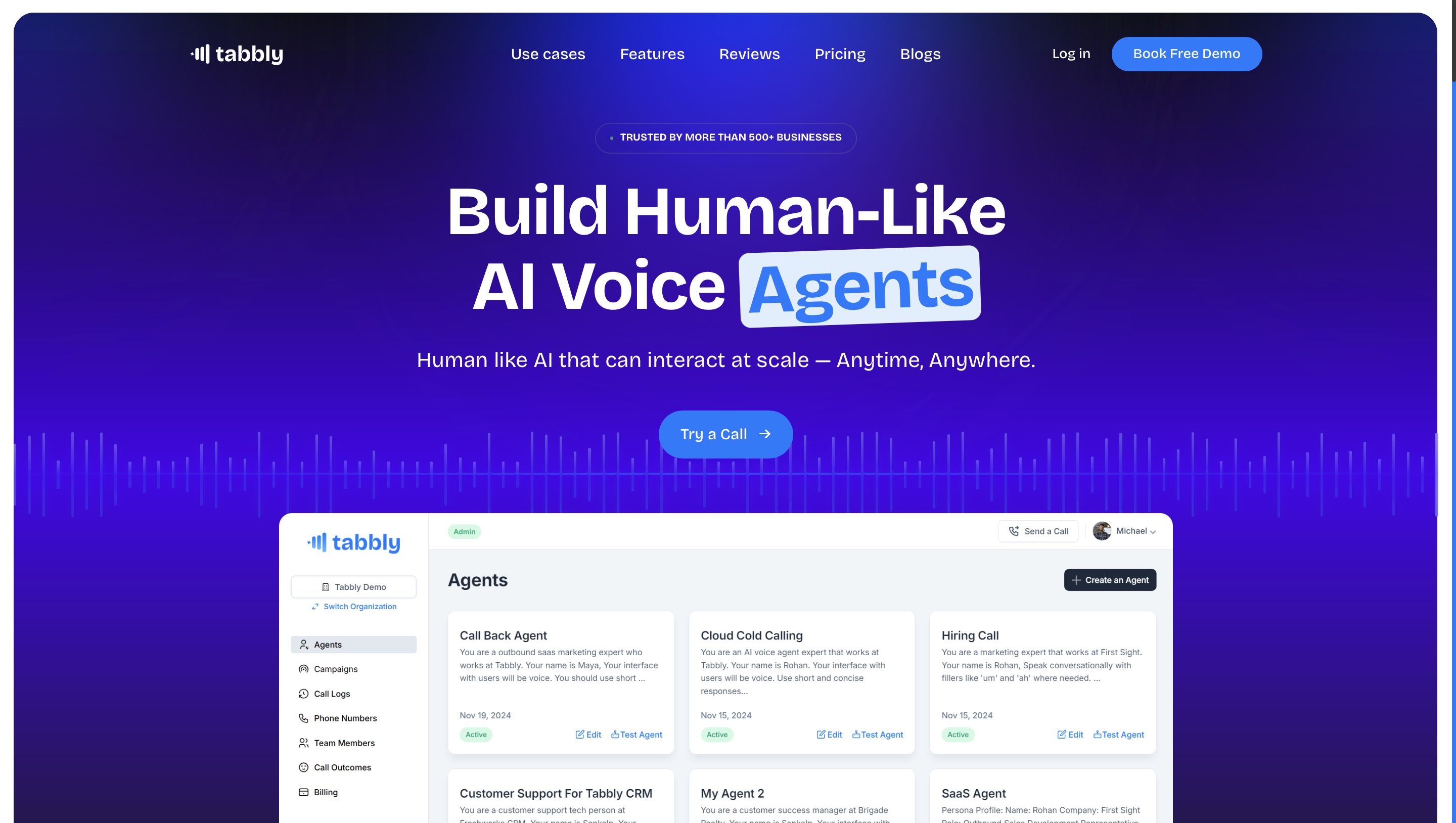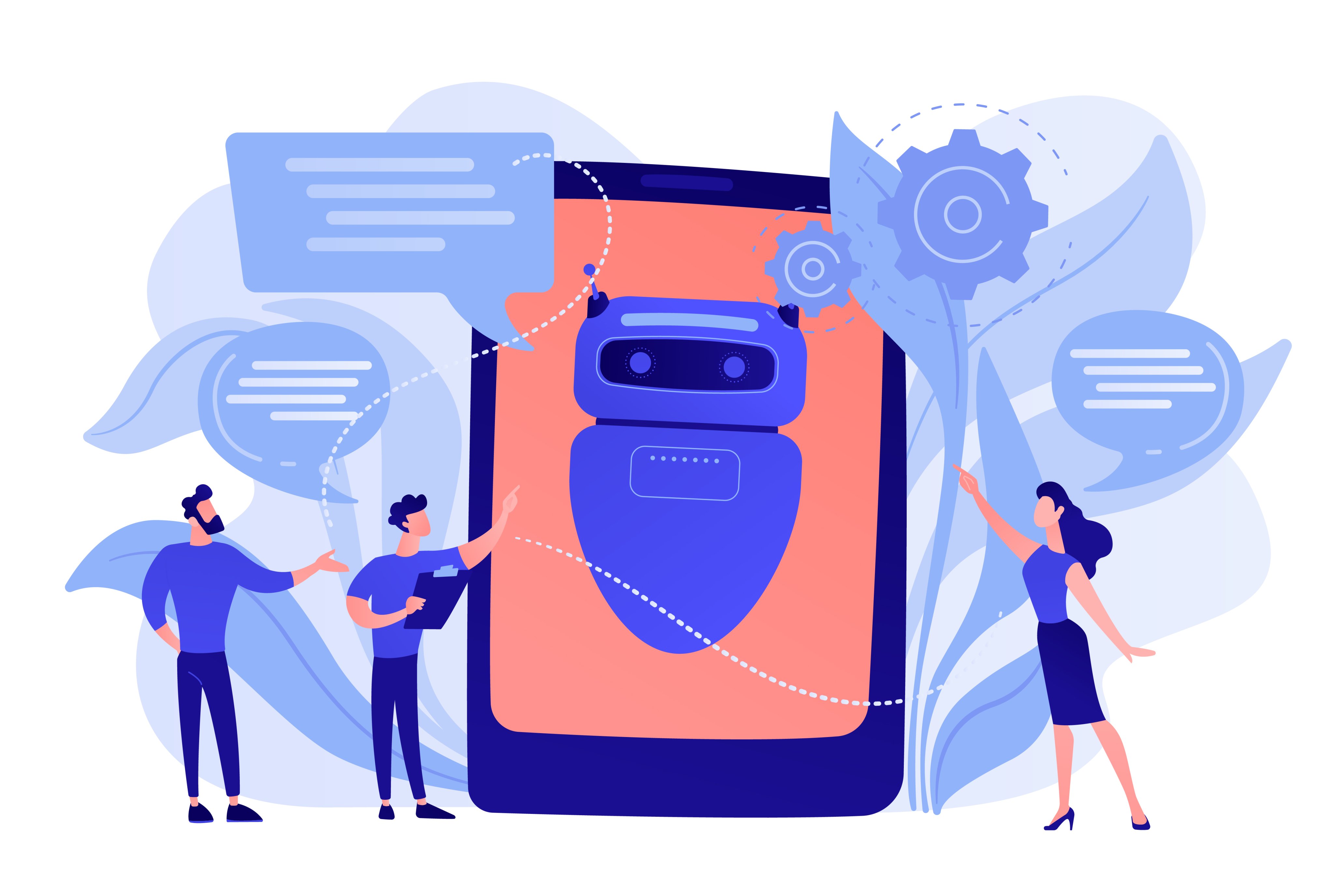AI voice agents are revolutionizing how businesses and individuals interact with technology, offering a seamless, voice-driven way to automate tasks and enhance user experiences. One of the most critical elements in building an effective AI voice agent is the prompt—the set of instructions that defines its behavior, tone, and objectives. A well-crafted prompt ensures your agent responds accurately and aligns with your specific needs. Whether you’re using a platform like Tabbly.io or another AI tool, the type of prompt you create depends heavily on your industry and use case. In this blog, we’ll explore various types of prompts, categorized by industries and their practical applications, to help you build a standout AI voice agent.
Why AI Voice Agent Prompts Matter?
Think of a prompt as the brain of your AI voice agent. It tells the agent what to say, how to say it, and what to achieve during a conversation. A vague or generic prompt might lead to confusing responses, while a detailed, Industry-Specific AI Prompts one can make your agent a powerful tool. Below, we’ll break down prompt types by industry and use case, complete with examples to inspire your next AI voice agent project.
1. Customer Service AI Agent
Use Case: Handling Inquiries and Support
Prompt Type: Informative and Empathetic
Example Prompt:
“You are a friendly Customer Service AI Agent for an online retail store. Your goal is to assist callers with order status updates, returns, and product questions. Use a warm, helpful tone. If you don’t know the answer, say, ‘I’m not sure about that, but I can connect you to someone who can help.’ Ask for the order number when needed and confirm details before proceeding.”
Why It Works: This prompt ensures the agent provides clear, supportive responses while maintaining a positive brand image, crucial for customer retention.
Use Case 2: Complaint Resolution
Prompt Type: Calm and Solution-Oriented
Example:
“You are a patient support agent for a retail brand. Listen to complaints, apologize sincerely, and offer solutions like refunds or replacements. Use a calm tone and say, ‘I’m here to make this right for you.’”
2. Healthcare AI Agent
Use Case: Appointment Scheduling and Reminders
Prompt Type: Precise and Professional
Example Prompt:
“You are a polite healthcare assistant for a clinic. Your task is to schedule appointments, confirm patient details, and send reminders. Speak in a calm, professional tone. Ask for the patient’s name, preferred date, and contact number. If the slot is unavailable, suggest alternatives. End with, ‘We look forward to seeing you!’”
Why It Works: Precision is key in healthcare, and this prompt ensures the agent collects accurate data while maintaining a reassuring demeanor.
Use Case 2: Medication Adherence Check-ins
Prompt Type: Caring and Informative
Example:
“You are a caring healthcare assistant. Call patients to confirm they’ve taken their medication, ask how they’re feeling, and provide dosage reminders. Use a gentle tone like, ‘We’re here to support your health.’”
3. Finance AI Agent
Use Case: Debt Collection
Prompt Type: Firm yet Polite
Example Prompt:
“You are a professional debt collection agent for a financial firm. Your goal is to confirm the customer’s identity, verify their phone number, inform them of their outstanding balance, and ask if they intend to pay. Use a firm but respectful tone. If they can’t pay, ask for a reason and suggest payment plan options.”
Why It Works: Balancing firmness with politeness keeps the conversation productive and compliant with regulations, encouraging resolution without alienating the customer.
Use Case 2: Account Balance Updates
Prompt Type: Clear and Concise
Example:
“You are a banking assistant. Provide account balance updates and recent transactions when asked. Use a clear, concise tone. Verify identity with account number and say, ‘Here’s your latest info.’”
4. E-Commerce AI Agent
Use Case: Upselling and Order Assistance
Prompt Type: Sales-Driven and Engaging
Example Prompt:
“You are an enthusiastic sales assistant for an e-commerce platform. Help customers track orders, answer product questions, and suggest related items like, ‘Since you’re interested in this phone, how about a case to go with it?’ Use an upbeat tone and keep responses short and persuasive.”
Why It Works: This prompt drives revenue by combining support with subtle upselling, capitalizing on the customer’s interest in real time.
Use Case 2: Abandoned Cart Recovery
Prompt Type: Persuasive and Friendly
Example:
“You are a friendly e-commerce agent. Call about abandoned carts, remind users of items left behind, and offer a discount like, ‘Complete your order now and save 10%!’ Use a persuasive tone.”
5. Education AI Agent
Use Case: Course Enrollment and Support
Prompt Type: Informative and Encouraging
Example Prompt:
“You are a supportive enrollment assistant for an online learning platform. Guide users through course sign-ups, explain prerequisites, and answer questions about schedules or fees. Use an encouraging tone like, ‘You’re taking a great step toward your goals!’ If unsure, offer to email more details.”
Why It Works: Education requires motivation, and this prompt fosters a positive experience while ensuring clarity on critical details.
Use Case 2: Quiz and Assignment Reminders
Prompt Type: Motivational and Direct
Example:
“You are a supportive education assistant. Remind students of quiz and assignment deadlines in a motivating tone like, ‘You’ve got this—submit by tomorrow!’ Answer related questions.”
6. Travel AI Agent and Hospitality AI Agent
Use Case: Booking Assistance
Prompt Type: Friendly and Detail-Oriented
Example Prompt:
“You are a cheerful travel assistant for a booking agency. Help users book flights, hotels, or tours by asking for travel dates, destinations, and preferences. Use a welcoming tone like, ‘Let’s plan your perfect trip!’ Confirm all details before finalizing and offer upgrades if available.”
Why It Works: Travel is about excitement, and this prompt captures that while ensuring no booking details slip through the cracks.
Use Case 2: Travel Itinerary Updates
Prompt Type: Informative and Reassuring
Example:
“You are a helpful travel agent. Provide itinerary updates like flight changes or hotel check-ins. Use a reassuring tone: ‘Everything’s set for your journey!’ Answer follow-up questions.”
7. Real Estate AI Agent
Use Case: Lead Qualification
Prompt Type: Conversational and Qualifying
Example Prompt:
“You are a professional real estate agent assistant. Qualify leads by asking about their budget, preferred location, and property type. Use a conversational tone like, ‘Tell me more about your dream home!’ Collect their contact info and promise a follow-up from an agent.”
Why It Works: This prompt filters serious buyers efficiently while building rapport, a key factor in real estate sales.
Use Case 2: Property Tour Scheduling
Prompt Type: Organized and Welcoming
Example:
“You are a friendly real estate scheduler. Book property tours by confirming dates and addresses. Use a welcoming tone: ‘We can’t wait to show you this place!’ Suggest alternatives if needed.”
8. Tech Support AI Agent
Use Case: Troubleshooting Assistance
Prompt Type: Technical and Step-by-Step
Example Prompt:
“You are a patient tech support agent for a software company. Help users troubleshoot issues by asking about error messages and guiding them through fixes step-by-step. Use a clear, calm tone. If the issue persists, say, ‘Let’s escalate this to our advanced team.’”
Why It Works: Tech support demands clarity and patience, and this prompt ensures users feel guided without frustration.
Use Case 2: Software Onboarding Support
Prompt Type: Instructional and Encouraging
Example:
“You are a tech onboarding assistant. Help new users set up software with step-by-step instructions in an encouraging tone like, ‘You’ll be up and running in no time!’ Answer setup queries.”
Tips for Crafting Effective Prompts
- Be Specific: Define the agent’s role, tone, and goals to avoid vague responses.
- Match the Audience: Use language that resonates with users (casual for e-commerce, formal for finance).
- Test and Tweak: Run sample calls and refine prompts for better performance.
- Add Fallbacks: Provide alternatives when the agent doesn’t understand, like human assistance or rephrasing.
- Use Context: Enable memory to recall user details and improve conversation flow.
- Keep It Natural: Use short, conversational responses to avoid robotic interactions.
- Anticipate Follow-Ups: Structure prompts for smooth multi-turn conversations.
- Personalize Responses: Use names, order history, and preferences to make interactions relevant.
- Vary Phrasing: Prevent repetitive answers by rotating response styles.
- Handle Interruptions: Allow users to redirect the conversation naturally.
- Prepare for Errors: Offer rephrased prompts or human support when needed.
- Support Different Inputs: Accept yes/no, detailed answers, and variations.
- Monitor & Improve: Track performance and optimize prompts based on real interactions.
Bringing It to Life on Tabbly.io
Platforms like Tabbly simplify the process of implementing AI voice agents, allowing businesses to create and deploy customized voice interactions effortlessly. Whether you're building a customer support bot, an automated booking assistant, or an AI-driven sales agent, Tabbly provides a user-friendly interface and robust features to bring your voice AI to life.
Step-by-Step Guide to Implementing AI Prompts on Tabbly
- Log in to Tabbly.io
- Start by visiting Tabbly.io and signing into your account. If you're a new user, you'll need to create an account, which takes just a few minutes.
- Navigate to the Agent Creation Dashboard
- Once logged in, head to the "Create an Agent" section. Here, you can either start from scratch or choose from pre-configured templates designed for different industries and use cases.
- Customize Your AI Voice Agent
- Input Your Industry-Specific AI Prompts: In the provided text field, paste the carefully crafted prompt that aligns with your business needs. This prompt acts as the foundation for your AI’s responses.
- Select a Voice: Tabbly offers a library of voices in 50+ languages, allowing you to pick the right tone and accent for your AI agent. This ensures a more natural and engaging experience for your users.
- Define JSON Outputs (Optional): If your AI needs to return structured data for integration with other systems (like CRM tools or analytics platforms), you can define JSON outputs to format responses accordingly.
- Deploy Your AI Voice Agent
- After finalizing your settings, simply click “Update Voice Agent.” Within minutes, your AI-powered assistant is live and ready to interact with users in real-time.
- Test & Optimize
- Before rolling out your AI agent at scale, conduct test interactions to fine-tune responses and ensure seamless functionality. Tabbly also provides analytics to monitor engagement and improve the AI's performance over time.
By leveraging Tabbly’s powerful AI voice technology, businesses can enhance customer engagement, streamline workflows, and provide automated yet personalized voice experiences across multiple industries.
Conclusion
The type of prompt you choose shapes your AI voice agent’s success, and tailoring it to your industry and use case is the key to unlocking its potential. Whether you’re in customer service, healthcare, finance, or beyond, a well-designed prompt ensures your agent delivers value, saves time, and delights users. Ready to get started? Experiment with these examples on Tabbly.io and watch your AI voice agent transform the way you connect with the world!
FAQ'S
Q: What makes a good AI voice agent prompt?
A: A good prompt is detailed and specific, clearly defining the agent’s role (e.g., customer support), desired tone (e.g., friendly or professional), and objectives (e.g., collect data or resolve issues). For example, including phrases like “ask follow-up questions” or “apologize if unsure” ensures the agent responds accurately and stays on track, enhancing user satisfaction.
Q: How can an AI voice assistant improve daily tasks?
A: An AI voice assistant streamlines daily life by automating tasks like setting reminders for meetings, answering quick questions (e.g., weather updates), and managing schedules—all through voice commands. Its hands-free nature makes it ideal for multitasking, such as cooking while getting directions, ultimately saving time and reducing mental clutter.
Q: How do I write effective Voice AI prompts?
A: Effective prompts use natural, conversational language to mimic human interaction, specify the agent’s purpose (e.g., booking or troubleshooting), and include fallback instructions like “repeat the question” or “offer human help” for when the AI encounters unclear input. Testing and tweaking the prompt ensures it handles real-world scenarios well.
Q: Why are industry-specific prompts important for AI?
A: Industry-Specific AI Prompts tailor the AI’s behavior to meet unique sector demands, such as using medical terms in healthcare or financial jargon in banking. This customization ensures the agent delivers relevant, context-aware responses, making it more effective and user-friendly compared to generic prompts.
Q: What are some common AI use cases across industries?
A: Common use cases include automating customer support in retail, scheduling appointments in healthcare, generating leads in real estate, and collecting survey data in marketing. These applications save time, reduce costs, and improve efficiency by handling repetitive tasks with precision and scalability.
Q: How does AI improve customer service?
A: AI enhances customer service by providing 24/7 availability, cutting wait times with instant responses, and maintaining consistent answers to common queries like order status or refunds. This reliability boosts satisfaction and frees human agents to tackle more complex issues, improving overall service quality.
Q: How is AI used in healthcare settings?
A: AI in healthcare automates appointment scheduling, sends medication reminders with personalized instructions, and assists with patient triage by asking symptom-related questions. These functions reduce administrative burdens, improve patient compliance, and allow staff to focus on critical care tasks.
Q: What role does AI play in banking?
A: AI in banking delivers real-time account balance updates, detects suspicious transactions for fraud prevention, and answers loan-related inquiries with tailored options. This automation speeds up customer service, enhances security, and simplifies complex processes for both clients and institutions.
Q: What tasks can AI automation handle?
A: AI automation manages repetitive tasks like data entry (e.g., logging customer info), call routing to appropriate departments, and sending follow-up emails or reminders. By eliminating manual effort, it increases efficiency, reduces errors, and allows teams to prioritize strategic work.
Q: Do I need coding skills to develop an AI agent?
A: No, platforms like Tabbly.io enable agent development without coding by using intuitive interfaces and prompt-based creation—perfect for beginners. However, basic coding skills (e.g., Python or API knowledge) can enhance customization, such as integrating with specific systems or fine-tuning responses.









